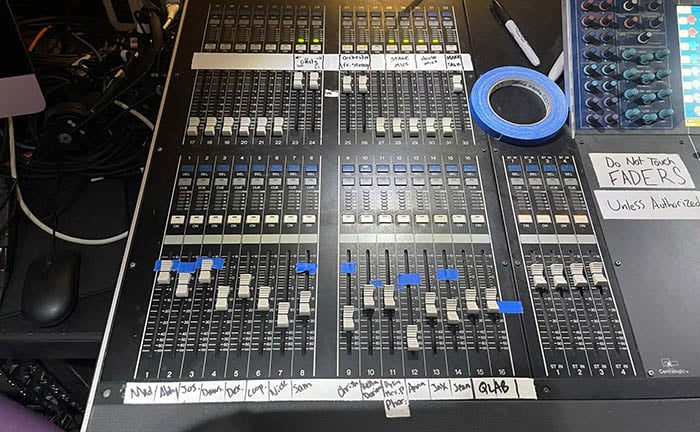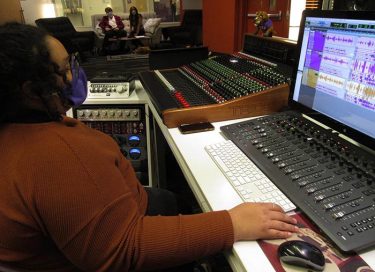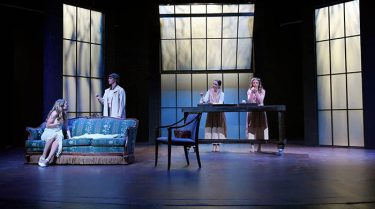
By Rick Vacek
GCU News Bureau
Sound design is an underappreciated aspect of theatre. You first notice the actors. Then the set design. The sound? Seems pretty simple – just make sure the microphones are turned on.
It’s far more complicated than that, of course. One look at any soundboard will tell you that. But senior Daniella Brown has made it look easy.

“It’s one of the only elements in the theatre, technically, that you don’t see with your eyes,” the Grand Canyon University senior said. “There’s a lot of nuance that goes into it that not a lot of people realize. The more I learn about it, the more I’m fascinated.”
And the more she learns, the more her skills are evident as she continues to expand her knowledge base.
Earlier this year, she won a regional sound design competition at the Kennedy Center American College Theater Festival against students from universities in Arizona, California, Nevada, Utah and Hawaii.
That earned her a spot in the national competition. Brown didn't win that one, but she enjoyed the virtual networking opportunities with sound designers who work on Broadway.
There’s no time to rest this summer. For the second consecutive year, she landed an impressive sound design gig on the East Coast, this time at the Contemporary American Theater Festival in Shepherdstown, West Virginia. She was a production audio technician last year at a Massachusetts event.
This comes after her sound work for about 10 performances at Ethington Theatre, where she just as easily could have been a regular onstage.
“Daniella Brown is a superstar,” GCU acting instructor Michael Kary said. “She’s a super talented actress. Very funny. She has a theatrical brain – a storytelling brain. But she’s learning about the technical aspects of theatre.”
Brown wasn’t sure what she wanted to do with her College of Arts and Media degree when she arrived at GCU. But when she expressed interest in sound design, the CAM faculty sent her to the GCU Recording Studio, where manager Eric Johnson was more than happy to give her a few pointers. He didn’t need to give her many.

“I showed her Pro Tools and a few things about microphones. We continued that training off and on for a couple of years as she was asked by classmates to get involved in other productions,” he said.
“In that very first production, she took to it like a fish to water. I was blown away at how quickly she picked up the concepts and began editing, mixing, recording and just organizing – how she was able to organize what a sound designer needs to organize. She really did a lot of learning on her own. All I did was give her some building blocks.”
Brown’s organizational abilities have been further expanded by producing the sound for two radio dramas in the Recording Studio, most recently “Little Women.”
Johnson conducted a pre-production meeting, showing the students how to set up microphones in the middle of the studio and think of it as the stage. Brown took it from there, and before long she was slamming doors and making other sounds needed for a radio show.
“Live theatre has so many different elements and components, different people working on different things that come together to create a world. In the radio drama, I totally, as the sound designer, create the entire world,” she said.
“I just have the actors say their lines, and I create the atmosphere by creating sound effects to suggest whether they’re moving a chair or if they’re outside or if they open and close a door. If there’s any suggestion of movement, it’s my job to create those things.
“It’s very different and a bit more intense than working on a live show. But, essentially, it’s the same thing – we’re just building a story and creating a world.”

The first radio drama, “It’s a Wonderful Life,” was an idea hatched by Brown and a friend last year. All Brown had to do was ask, and her mentors quickly made it happen. She had two assistants last year but went solo on “Little Women.”
Kary also had her produce the sound for his one-man show, “Every Brilliant Thing.”
“One of my first paid gigs,” she said.
She has big plans for future paid gigs. She’d like to work on Broadway or in a touring Broadway show, which demonstrates the value of those networking opportunities in the Kennedy Center competition.
For now, she’s focused on continuing her evolution through her senior year – with the continued assistance of the CAM faculty and the Recording Studio.
“When I expressed interest, the best thing they did for me was give me the space to do what I wanted – use the facilities and use time in class and in rehearsals to sharpen and learn my craft,” she said. “Any crazy idea I had, they supported me wholeheartedly.”
Said Dr. Craig Detweiler, the Arts and Media dean, “Daniella has demonstrated what the Lopes Live Labs are all about — hands-on experimentation with professional tools. She’s taken the initiative to go further with her Arts and Media education, polishing her skills so that industry leaders notice. We’re so proud of Daniella!”
Contact Rick Vacek at (602) 639-8203 or [email protected].
****
Related content:
GCU Today: Fine Arts student likes sound of theatre festival job
GCU Magazine: Fine Arts students act on ideas in Lopes Live Labs
GCU Today: Students to bring 'It's a Wonderful Life' to radio















